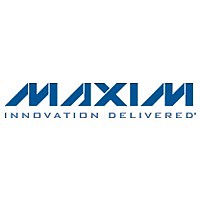MAX1879EUA-T Maxim Integrated Products, MAX1879EUA-T Datasheet - Page 8

MAX1879EUA-T
Manufacturer Part Number
MAX1879EUA-T
Description
Battery Management 1-Cell Li+ Pulse Charger
Manufacturer
Maxim Integrated Products
Datasheet
1.MAX1879EUAT.pdf
(11 pages)
Available stocks
Company
Part Number
Manufacturer
Quantity
Price
Simple, Efficient, 1-Cell Li+ Pulse Charger
The MAX1879 initiates fast-charge upon insertion of a
battery or application of an external power source (cur-
rent-limited AC wall adapter). After charge completion,
charging restarts if the cell voltage falls below 4.0V or
when THERM is pulled above 1.4V after the charge
timer expires (approximately 6.25hr).
Before a charge cycle can begin, cell conditions are
verified to be within safe limits. The cell voltage must be
greater than 2.5V but less than the regulation voltage
(default value 4.2V). In addition, the thermistor must
indicate an acceptable cell temperature (default range
+2.5°C to +47.5°C). See the Applications Information
section.
Li+ cells can be damaged when fast-charged from a
completely dead state. Moreover, a fully discharged
cell may indicate a dangerous abnormal cell condition.
As a built-in safety feature, the MAX1879 precharges
the Li+ cell with 8mA at the start of a charge cycle if the
cell voltage is below 2.5V. As soon as the cell reaches
2.5V and the safety conditions are met (see the Fast-
Charge section), fast-charging begins.
If the temperature moves outside the programmed
range, the charger pauses. When the temperature
returns to the safe charging range, the charging cycle
continues, and the charge timer resumes counting from
the point at which the temperature fault occurred. The
timer is not reset. The MAX1879 monitors these condi-
tions throughout the charging cycle.
Once cell conditions are determined to be satisfactory,
the MAX1879 fast-charges the Li+ cell by pulling GATE
low, turning on the external PMOS FET. Cell charging
current is set by the current limit of the external power
supply; it is not regulated by the MAX1879. The PMOS
FET operates only as a switch, not as a linear regulator.
Therefore, power dissipation is minimized, permitting
rapid charge cycles with minimal heat generation. The
external power supply must have a specified current
limit that matches the desired fast-charge current for
the Li+ cell.
The MAX1879 uses a hysteretic algorithm with mini-
mum on-times and minimum off-times to top-off the cell.
The cell voltage is sampled every 2ms. If V
than the battery regulation voltage, the external PMOS
FET turns on or remains on. If the cell voltage is greater
than or equal to the battery regulation voltage, the FET
turns off and remains off for the minimum off-time. By
measuring the cell voltage when the PMOS FET is off
as well as when it is on, the MAX1879 eliminates bat-
8
_______________________________________________________________________________________
Detailed Description
Initiating a Charge Cycle
Fast-Charge
BATT
is less
tery-voltage sensing errors due to charging current
flowing through the series resistance of cell protection
switches or fuse links in the charging path. Fast-charge
continues until the on/off duty cycle falls to 1/8, then the
CHG LED turns off, indicating that the battery is
charged to approximately 95% of full capacity.
At the beginning of the Top-Off state, the current stays
on for a 1/8 duty cycle. As the cell continues to charge,
the percentage of time spent in the “current-on” mode
decreases. Towards the end of top-off, the current
stays off for many cycles between single “on” pulses.
During these final pulses, the instantaneous cell voltage
may exceed the battery regulation voltage, but the
duration of these pulses is several orders of magnitude
shorter than the intrinsic chemical time constant of the
Li+ cell. This does not harm the cell. Cell top-off is com-
pleted when the charging timer expires (approximately
6.25hr).
CHG indicates the cell’s charging status. An LED can
be connected directly from IN to CHG for a visible indi-
cator. Alternatively, a pullup resistor (100kΩ) from a
logic supply to CHG provides a logic-level output.
Table 1 relates the LED status to the charger condition.
The MAX1879 was designed to offer the maximum inte-
gration and functionality in the smallest, most basic
application circuit possible. The only necessary exter-
nal components are a current-limited wall cube, a
PMOS FET, two small capacitors, and a 10kΩ thermis-
tor/resistor. This simple application circuit appears in
Figure 1. Optionally (as shown in Figure 2), an LED can
be added as a charge-state indicator, a resistor (R
can be used to trim down the maximum charge voltage
Table 1. CHG Output States
No battery or no charger, or
cell voltage < 2.2V
Fast-charge in progress
Top- Off: on/off d uty cycl e < 1/8
Done (charge complete)
Temperature fault
Prequalification
(2.2V < V
CONDITION
BATT
< 2.5V)
Applications Information
Charge Status with CHG
Pulsed Top-Off Charge
High impedance (LED off)
Low (LED on)
High impedance (LED off)
High impedance (LED off)
LED blinks at 2Hz
LED blinks at 2Hz
CHG (LED)
ADJ
)












